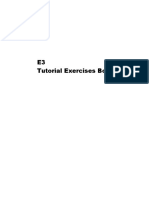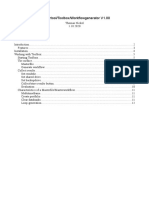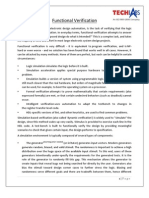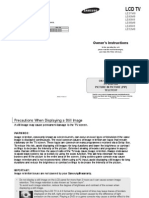Aldec Active-HDL Simulation
Aldec Active-HDL Simulation
Uploaded by
Sushil KumarCopyright:
Available Formats
Aldec Active-HDL Simulation
Aldec Active-HDL Simulation
Uploaded by
Sushil KumarOriginal Description:
Copyright
Available Formats
Share this document
Did you find this document useful?
Is this content inappropriate?
Copyright:
Available Formats
Aldec Active-HDL Simulation
Aldec Active-HDL Simulation
Uploaded by
Sushil KumarCopyright:
Available Formats
Tutorial on
Simulation
using
Aldec Active-HDL
Ver 2.0
by Shashi Karanam, Kishore Kumar Surapathi
lnLroducLlon
AcLlve-PuL ls an lnLegraLed envlronmenL deslgned for developmenL of vPuL deslgns. 1he core of
Lhe sysLem ls a vPuL slmulaLor. Along wlLh debugglng and deslgn enLry Lools, lL makes up a compleLe
sysLem LhaL allows you Lo wrlLe, debug and slmulaLe vPuL code. 8ased on Lhe concepL of a deslgn,
AcLlve-PuL allows you Lo organlze your vPuL resources lnLo a convenlenL and clear sLrucLure.
SLudenLs can use AcLlve-PuL Lo perform followlng Lasks:
developmenL of Lhe vPuL based deslgns,
funcLlonal slmulaLlon of Lhelr code,
funcLlonal slmulaLlon of Lhe synLheslzed code,
Llmlng slmulaLlon of Lhe hardware lmplemenLaLlon.
!"#$%&'($)
1hls LuLorlal helps you Lo
CreaLe a new deslgn or add .vhd flles Lo your deslgn
Complle and debug your deslgn
erform slmulaLlon
noLe : 1hls LuLorlal does noL explaln Lhe synLhesls or lmplemenLaLlon sLeps.
*&+,&-./)
)
1. SLarL >> vLSl 1ools >> AcLlve-PuL 8.2
!
!
!
!
!
"#!$%&%'(!')%"(%!*%+!+,)-./"'%!"*0!'&1'-!234!')%"(%.!*%+!+,)-./"'%!1*!5,6)!01)%'(,)5#!
7#!$%&%'(1*8!,/%*!%91.(1*8!+,)-./"'%!81:%.!5,6!(;%!,/(1,*!(,!';,,.%!<),=!5,6)!/)%:1,6.!>,)-./"'%?.#!
!
!
!"!! @5/%! (;%! *"=%! "*0! .%&%'(! &,'"(1,*! ,<! 5,6)! 0%.1)%0! +,)-./"'%! "*0! '&1'-! #$#! A<! 5,6?)%! 6.1*8!
.';,,&?.! &"74! 1(! 1.! )%',==%*0%0! (,! +,)-! 1*! 5,6)! &,'"&?.! 0)1:%! BC! 0)1:%D4! ".! 5,6)! (;6=7! 0)1:%! "*0! 5,6)!
*%(+,)-!0)1:%!B3!0)1:%D!")%!.&,+#!E,)!*,+4!6.%!F&"70%=,G!".!5,6)!+,)-./"'%#!
!
!
!
!
!
!
!
!
!
%"! $%&%'(!&'()*(+),+-./*0+1(234,4!"*0!'&1'-!5(6*#!
!
!
!
!"! "#$$%&!'($)*!+,-./-0!)$12,.3/-4,$1!-%!#$%&'()*+#,*(&-.'&.&!-1+!5&2-3(4!657!(-1.3-.&!-%!/+#,8!
7&-9&!4#&!:-/.&4!:&)#1$($.;!'(-1*%!-%!1$4!+&2,1&+8!"(,)*!0$1)<!
!
!
!
!
!
!
!"! "#$%!&'%!(%)*+,!,-.%!#/0!1-,&!&/!23%-&%!-,(!45*26!#$%&7!8/3!&'*)!&0&/3*-59!0)%!:-,(+-&%;!-)!#/03!
(%)*+,!,-.%7!
!
!
!
!
!"!! "#$%&'!'()#!('*!*#$%&'!*%+#,-.+/!0%11!2#!*%$31(/#*!3+.,##*!45+-6#+!2/!,1%,7%'&!#$%$&'8!!
!
!
!
!"!! "#!$%&!'&($!)#*+,-./&!.01!0&)!1&,230!.*&!12,-'.4&15!
!
!
!
!
#"!! 6#7!/.0!.11!.'*&.14!&82,$203!9:;<!,#7*/&!(2'&,5!"#!/*&.$&!.!0&)!9:;<!,#7*/&!(2'&!7,203!$%&!,#7*/&!
/#1&!)2=.*1!$%&'%&(!
&
6
2. Compiling designs
Compilation of the VHDL code is necessary to create simulation model of
the described circuit. The compiler checks all the syntax and writes all the
necessary information in the internal binary format. It should be clearly noted that
the compilers ability to find errors is limited to syntax errors only. Many other
errors and mistakes can be found only when performing thorough simulation. It is
also important to understand that the compilation does not produce any
synthesized code for implementation purposes. This task is performed in
Foundation Series exclusively.
2.1 Compiling selected files
Select the file you want to compile and press button or press F11 on
the keyboard. This will start compilation.
7
If everything went right during the compilation, you should see check mark
near your file. You can also expand the branch headed by the library icon to
see that all compiled entities and architectures have been added to the project
library.
check mark
compiled
entities
messages
from
compiler
If the compilation process did not end with success, the compiler will
produce meaningful descriptions of errors. All places in your code where errors
were found will be highlighted.
errors found in
this entity
architecture has
not been
compiled to the
library
located errors
8
2.2 Compiling all files
The entire design can be compiled at once by pressing buttons: or .
If all the entities in the design are organized in the clear hierarchical structure, the
compiler will automatically recognize the top-level entity. However, if distinct
hierarchies of entities exist, the compiler will leave the choice of the top-level
entity for you.
More than one
top-level entities
detected
9
3. Simulating the design
Simulation can be performed when the entire design has been
successfully compiled. It means that the simulation model of all elements has
been created. Simulator can be configured to stimulate all inputs to the circuit,
however students should learn to write test benches top-level testers described
behaviorally. The task of test bench is to produce all the stimulation to the tested
circuit to verify its correctness. Once the test bench is created, performing
simulation becomes an easy task.
Simulation is performed in a graphical way simulator plots waveforms of
all signals being of designers interest. To create an empty waveform click on the
button . Next add desired signals by clicking on the button .
select desired
signals
signals can be selected
from any level in hierarchy
10
When you are done with adding signals, you can attempt to perform
simulation. There are three slightly different ways to run it:
by pressing button - the simulation will run until you will stop it by pressing
.
by pressing button - the simulation will run until specified point of time will
be reached.
by pressing button - the simulation will run for specified amount of time.
The result of simulation is represented in the form of waveforms.
You can always restart simulation by pressing button .
You might also like
- Continuum Plain English Reference ManualDocument740 pagesContinuum Plain English Reference ManualWilliamAlfonsoSanchezPaezNo ratings yet
- OOP CompleteDocument173 pagesOOP CompleteWahaj QureshiNo ratings yet
- Capstone Project Manuscript OutlineDocument2 pagesCapstone Project Manuscript OutlineDavid Andrew Divina Fariñas100% (2)
- Cadence IUS TutorialDocument7 pagesCadence IUS TutorialYeu EmNo ratings yet
- Lab2 Synopsys DCDocument12 pagesLab2 Synopsys DCkrunalNo ratings yet
- Debugging ModelDocument13 pagesDebugging ModelDENNIS songNo ratings yet
- Lab Manual 1 BDocument14 pagesLab Manual 1 BSyed Moiz AliNo ratings yet
- ELEC313 Lab#3Document10 pagesELEC313 Lab#3Ali MoharramNo ratings yet
- Active Tutorial 3Document8 pagesActive Tutorial 3belpcmNo ratings yet
- Selenium IDE: Installation Launch The IDEDocument21 pagesSelenium IDE: Installation Launch The IDEhariniNo ratings yet
- Ece745: Asic Verification Lab Assignment #1: Questa Systemverilog TutorialDocument12 pagesEce745: Asic Verification Lab Assignment #1: Questa Systemverilog TutorialGarry ManochaNo ratings yet
- Product ATMEL AVR AVRStudioUserGuideDocument15 pagesProduct ATMEL AVR AVRStudioUserGuidemike_helplineNo ratings yet
- Lab Manual 1Document15 pagesLab Manual 1Shivam ShuklaNo ratings yet
- Don'T Panic: An Introductory Guide To The 6.001 Computer System Edition 1.3 January 18, 2001Document25 pagesDon'T Panic: An Introductory Guide To The 6.001 Computer System Edition 1.3 January 18, 2001Abbey FactoraNo ratings yet
- Uji 1Document18 pagesUji 1Nathan OngNo ratings yet
- Keil DebuggingProgramsDocument22 pagesKeil DebuggingProgramsgame hackerNo ratings yet
- AVR Studio User GuideDocument22 pagesAVR Studio User Guidemike_helplineNo ratings yet
- Вводный курс программирования 1st - stageDocument37 pagesВводный курс программирования 1st - stageclarionchikNo ratings yet
- AVR Studio User Guide PDFDocument15 pagesAVR Studio User Guide PDFPedro MoncadaNo ratings yet
- Simulation and Synthesis of Full Adder Using CadenceDocument9 pagesSimulation and Synthesis of Full Adder Using CadenceHarithaNo ratings yet
- Cs3691 Embedded and Iot Lab ManualDocument123 pagesCs3691 Embedded and Iot Lab Manual21csa48No ratings yet
- LAB 1C. Full Adder in VHDLDocument11 pagesLAB 1C. Full Adder in VHDLHANIA TARIQNo ratings yet
- Lab 1Document24 pagesLab 1Pierce NgNo ratings yet
- E3tutorial Exercises UsDocument41 pagesE3tutorial Exercises UsKarthik NNo ratings yet
- PCSpim TutorialDocument5 pagesPCSpim Tutorialsimona13No ratings yet
- Lab 4Document4 pagesLab 4Arif KamalNo ratings yet
- New ManualDocument65 pagesNew Manualkarthiha megavarnamNo ratings yet
- Eclipse Tutorial and First Program: Java & Eclipse Platform Oulu, Spring 2005Document16 pagesEclipse Tutorial and First Program: Java & Eclipse Platform Oulu, Spring 2005Catdog CatNo ratings yet
- Lab 1Document8 pagesLab 1Masud SarkerNo ratings yet
- Guide For The VLSI Chip Design CAD Tools at Penn StateDocument27 pagesGuide For The VLSI Chip Design CAD Tools at Penn StatesriNo ratings yet
- Lab Manual For ECE 455 Spring, 2011 Department of Electrical and Computer Engineering University of WaterlooDocument39 pagesLab Manual For ECE 455 Spring, 2011 Department of Electrical and Computer Engineering University of Waterlooguru87.joshi3473No ratings yet
- OptiSystem Tutorials Volume 1-101-200Document100 pagesOptiSystem Tutorials Volume 1-101-200Mohamed Aly SowNo ratings yet
- Cadence Tools Command ReferenceDocument5 pagesCadence Tools Command ReferenceEmmanuel KishoreNo ratings yet
- NXP LPC1768 & Keil Quadcopter Project Lab Manual PDFDocument99 pagesNXP LPC1768 & Keil Quadcopter Project Lab Manual PDFakozyNo ratings yet
- General Lab InstructionsDocument3 pagesGeneral Lab InstructionsJATIN AGGARWALNo ratings yet
- CM72L1eL - M5 - A0 Create and Run A Sequence R.1.3 - 20200623 PDFDocument12 pagesCM72L1eL - M5 - A0 Create and Run A Sequence R.1.3 - 20200623 PDFAriel Padilla RiosNo ratings yet
- Exp 1 Introduction To AVR StudioDocument4 pagesExp 1 Introduction To AVR StudioyagneshnmakwanaNo ratings yet
- Tutorial Eagle PDFDocument15 pagesTutorial Eagle PDFAhmad FathurachmanNo ratings yet
- Scilab FamiliarizationDocument9 pagesScilab FamiliarizationmbmonvilleNo ratings yet
- Debugger & Profiler in NetBeansDocument5 pagesDebugger & Profiler in NetBeanshuubangNo ratings yet
- ECP2046 CO2 Tri 2 20122013Document6 pagesECP2046 CO2 Tri 2 20122013Engr Ayaz KhanNo ratings yet
- Cadence NCVerilog Tutorial FL21Document6 pagesCadence NCVerilog Tutorial FL21Pruthvi MistryNo ratings yet
- STM Lab ManualDocument50 pagesSTM Lab Manualrasalaarchu1No ratings yet
- Embeddded Lab ManualDocument15 pagesEmbeddded Lab ManualkuralamudhuNo ratings yet
- Data ScienceDocument21 pagesData ScienceDanielNo ratings yet
- Guide For The VLSI Chip Design CAD Tools at Penn State, CSE DepartmentDocument28 pagesGuide For The VLSI Chip Design CAD Tools at Penn State, CSE DepartmentharivarahiNo ratings yet
- Synopsys Syn 2016Document15 pagesSynopsys Syn 2016Himanshu PatraNo ratings yet
- VeloCloud Lab Hol 2040 91 Net - PDF - enDocument10 pagesVeloCloud Lab Hol 2040 91 Net - PDF - enpaulo_an7381No ratings yet
- Introduction To Controlnet With Controllogix: Hands-On Lab WorkbookDocument91 pagesIntroduction To Controlnet With Controllogix: Hands-On Lab WorkbookisaorsNo ratings yet
- Exercise A1 - Simple Ogee SetupDocument20 pagesExercise A1 - Simple Ogee SetupCarlos Luis Oyuela Gomez100% (2)
- Inhaltsverzeichnis: Monitortool/Toolbox/Workflowgenerator V1.00Document12 pagesInhaltsverzeichnis: Monitortool/Toolbox/Workflowgenerator V1.00Jeadsada KongboonmaNo ratings yet
- Automation Studio IntroductionDocument84 pagesAutomation Studio IntroductionasdmhrdhNo ratings yet
- VraDocument322 pagesVrachowdaryNo ratings yet
- VLSI Xilinx ManualDocument87 pagesVLSI Xilinx Manualaishwarya_hariNo ratings yet
- Chapter0 PDFDocument9 pagesChapter0 PDFmikeNo ratings yet
- ECP Lab1 Simulink Intro r4Document6 pagesECP Lab1 Simulink Intro r4keyboard2014No ratings yet
- CS6316 - Network Simulation Lab 1Document6 pagesCS6316 - Network Simulation Lab 1deepakdewangan27No ratings yet
- Lab Wk02 Exercises - BasicsDocument6 pagesLab Wk02 Exercises - Basicsdyake04No ratings yet
- ConfigMgr - An Administrator's Guide to Deploying Applications using PowerShellFrom EverandConfigMgr - An Administrator's Guide to Deploying Applications using PowerShellRating: 5 out of 5 stars5/5 (1)
- COMPUTER PRODUCTIVITY BOOK 1 Use AutoHotKey Create your own personal productivity scripts: AutoHotKey productivity, #1From EverandCOMPUTER PRODUCTIVITY BOOK 1 Use AutoHotKey Create your own personal productivity scripts: AutoHotKey productivity, #1No ratings yet
- Energy Bands and Charge Carriers in SemiconductorsDocument7 pagesEnergy Bands and Charge Carriers in SemiconductorsSushil KumarNo ratings yet
- Tutorial AHDLDocument17 pagesTutorial AHDLSushil KumarNo ratings yet
- Arithmetic InstructionsDocument18 pagesArithmetic InstructionsSushil KumarNo ratings yet
- Data Moving: Onchip MemoryDocument17 pagesData Moving: Onchip MemorySushil KumarNo ratings yet
- Web2.0 in TchrEdDocument12 pagesWeb2.0 in TchrEdSushil KumarNo ratings yet
- Side 51Document14 pagesSide 51Sushil KumarNo ratings yet
- Np-Hard and Np-Complete ProblemsDocument26 pagesNp-Hard and Np-Complete ProblemsRijas RasheedNo ratings yet
- Module 11 Terminate and Connect of Electrical Wiring and Electronic CircuitsDocument40 pagesModule 11 Terminate and Connect of Electrical Wiring and Electronic CircuitsPatrick John LarenaNo ratings yet
- Operators and Technicians Manual: GEN3 Evolution® PrinterDocument56 pagesOperators and Technicians Manual: GEN3 Evolution® PrinterDiego ArroyaveNo ratings yet
- Technical Specification of 132 KV SubstationDocument481 pagesTechnical Specification of 132 KV SubstationParvej0% (1)
- The System Unit Processing and MemoryDocument13 pagesThe System Unit Processing and Memorymujaddadahmed93No ratings yet
- Programming Concepts PDFDocument20 pagesProgramming Concepts PDFDickerson Vallejos ManaloNo ratings yet
- ConturoMatic CV250 EDocument4 pagesConturoMatic CV250 ELeonardo Miguel100% (1)
- Process Control Fundamentals Related To Distributed Control System PDFDocument15 pagesProcess Control Fundamentals Related To Distributed Control System PDFRamesh NklNo ratings yet
- Guide: Beolab 7-1Document12 pagesGuide: Beolab 7-1Sasha HesenliNo ratings yet
- Mis 1Document19 pagesMis 1Yashveer ChopraNo ratings yet
- EEM336 - 01 - Introduction To The Microprocessor and ComputerDocument53 pagesEEM336 - 01 - Introduction To The Microprocessor and ComputersakalanNo ratings yet
- VSP MICROCODE VERSION 70-04-31-00/00-M117 RELEASED 07/12/2012 New Supported Features and Functions For Version 70-04-31-00/00-M117Document3 pagesVSP MICROCODE VERSION 70-04-31-00/00-M117 RELEASED 07/12/2012 New Supported Features and Functions For Version 70-04-31-00/00-M117imkzbyNo ratings yet
- BEI605 Embedded SystemDocument79 pagesBEI605 Embedded SystemKani Mozhi100% (2)
- Show Hidden Files Using Command Prompt - VisiHowDocument17 pagesShow Hidden Files Using Command Prompt - VisiHowdevinfNo ratings yet
- Datasheet MAG322-323Document2 pagesDatasheet MAG322-323BarnayNo ratings yet
- Catalog Prisma P 2012 (En)Document368 pagesCatalog Prisma P 2012 (En)mazu_bzNo ratings yet
- 2018 Firmware Update Instructions For Ver 8.53 PEH448H.AVH - PDFDocument7 pages2018 Firmware Update Instructions For Ver 8.53 PEH448H.AVH - PDFjavier_khanNo ratings yet
- 11B2 14 NF Smart Entry and Start System VNDocument41 pages11B2 14 NF Smart Entry and Start System VNMinh Nhat Phan100% (3)
- Neve 1073 1084 User Manual Issue5Document46 pagesNeve 1073 1084 User Manual Issue5pverdetNo ratings yet
- Office Ergonomics Self-Assessment Checklist: YES NODocument4 pagesOffice Ergonomics Self-Assessment Checklist: YES NOZainorin AliNo ratings yet
- Kba Reg D Da GBDocument56 pagesKba Reg D Da GBInsan AzizNo ratings yet
- OD332419967070910100Document3 pagesOD332419967070910100md.altaffNo ratings yet
- GUI LPC2103 Cau Trúc Phàn C NGDocument104 pagesGUI LPC2103 Cau Trúc Phàn C NGBắc HoàiNo ratings yet
- Stvep (Internet and Computing Fundamentals) : Activity Sheet Quarter 1 - LO 1Document11 pagesStvep (Internet and Computing Fundamentals) : Activity Sheet Quarter 1 - LO 1alenNo ratings yet
- (IJIT-V5I6P1) :mandakini Priyadarshani Behera, Prof. Sankarsan SahooDocument10 pages(IJIT-V5I6P1) :mandakini Priyadarshani Behera, Prof. Sankarsan SahooIJITJournalsNo ratings yet
- DSP Wiring 166 FaceliftDocument1 pageDSP Wiring 166 FaceliftZdravko BambovNo ratings yet
- Samsung LCD LE40N87BDDocument66 pagesSamsung LCD LE40N87BDgafaraNo ratings yet
- Mindray MEC1000 - Service ManualDocument61 pagesMindray MEC1000 - Service ManualManuel Vivero Diéguez100% (9)































































































